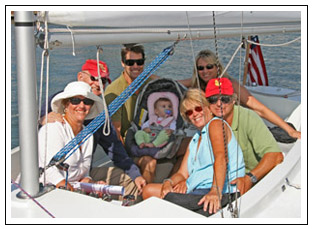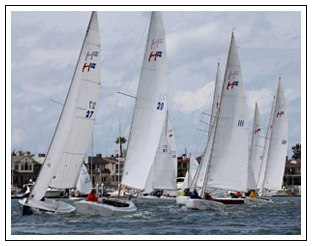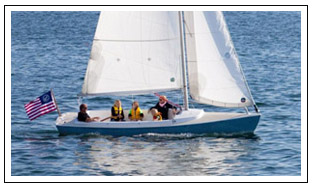|

A DREAM, 7 WISE MEN & THE PERFECT BOAT
 On a beautiful Thursday evening about fifteen years ago, a group of seven salty sailors at the Newport Harbor Yacht Club in Southern California were sitting in the bar wondering why so few of the yacht club members were sailing. This got them to dreaming about the perfect boat. One that would get husbands and wives, families and friends back on the water. On a beautiful Thursday evening about fifteen years ago, a group of seven salty sailors at the Newport Harbor Yacht Club in Southern California were sitting in the bar wondering why so few of the yacht club members were sailing. This got them to dreaming about the perfect boat. One that would get husbands and wives, families and friends back on the water.
After many more discussions on this topic, the salty seven came up with the perfect solution. A brand new 20-foot keel boat now known as the Harbor 20.
Each of the guys in the group had been an extremely competitive sailor in his day, but found himself sailing less each season. They had raced boats like the International 14, Star, Thistle, Etchells, Santana 20, Snipe, and Lido 14 but at 50+, they were no longer up to the physical requirements of these boats. And the hassle of racing larger boats had become a huge obstacle. The whole scenario of making twelve calls to get a crew of eight or nine together for a weekend race had definitely lost its appeal.
The more the guys talked, the more they realized how much they missed sailing and one-design racing. Surely there was a sailboat out there that could get the older sailors back on the water racing competitively and also get sailors of all ages out sailing with their families.
 In the “good old days”, sailing had been a lifestyle. Generations of families had focused their summertime activities around yacht club events. But all of this had changed as dozens of new leisure-time activities emerged to divert their attention. The number of entries in the racing events was dwindling, and many of the boats in the boatyard sat idle for most of the year.
In the “good old days”, sailing had been a lifestyle. Generations of families had focused their summertime activities around yacht club events. But all of this had changed as dozens of new leisure-time activities emerged to divert their attention. The number of entries in the racing events was dwindling, and many of the boats in the boatyard sat idle for most of the year.
The group that met at the bar that day set out to change this. The man with the vision was Arthur Strock, a renowned architect with a passion for detail. He had a beautiful power boat but hadn’t entered a sailboat race in years. Recognizing that there were a lot of other sailors just like him, he set out to find a sailboat that would get Newport Harbor Yacht Club members back into sailing. He spent two years going from builder to builder, and he looked at daysailers and small racing sailboats all over the world.
In the end, he decided that the perfect boat simply did not exist. He kept detailed records of his search and compiled a 30-page document describing the boat that would be perfect for the job.
 As Arthur did his homework, he continued to meet with the guys from that casual meeting at the bar. They were all staff commodores with outstanding racing credentials who definitely understood the importance of getting the members back into sailboats.
As Arthur did his homework, he continued to meet with the guys from that casual meeting at the bar. They were all staff commodores with outstanding racing credentials who definitely understood the importance of getting the members back into sailboats.
One of the members of that group was Tom Schock, past NHYC commodore, avid sailor, and owner of W. D. Schock Corp. Tom recognized the challenge faced by the yacht club, and he knew that it was a problem being faced by many other yacht clubs. He also knew that the future of sailing depended on finding new ways of making the sport more attractive. Junior programs were being enhanced to attract children to the sport, and exciting new high performance racing sailboats were being designed to entice young athletes, but nothing was being done to keep older sailors and busy young executives from abandoning the sport.
Based on Arthur’s study, the group zeroed in on the Criteria for their new design. They knew that the boat would need to be . . .
- A beautiful, timeless design
- Comfortable & efficient
- Easy to sail whether sailing single-handed, double-handed, or with the whole family
- Hassle-free
- Fast & competitive
- Fun for one-design racing
- Perfect for daysailing with the family
- Versatile
- And really easy to maintain
The Answer – The Harbor 20 – A 20-foot keel boat with a large cockpit and a self-tacking jib.
Another important member of the group was Steven Schock, a professional Engineer and Naval Architect with a lifetime of sailing experience. Steve designed the boat, focusing completely on the Criteria.
As a result, the Harbor 20 has a thoroughly modern and fast hull shape. The cockpit is huge. And the boat is equipped with things like cushions and the roller furling self-tacking Hoyt jib boom that makes it comfortable, efficient, and easy to sail.
The first Harbor 20 was launched in April of 1998. Within twelve years there were about 150 Harbor 20s sailing in Newport Beach. About 35 of these Harbor 20 owners actively race their boats, which means 115 Newport sailors love to daysail. Most of these daysailers join the class association so they can enjoy the parties, seminars, and lots of other special non-race sailing events. And the racers find the competition exciting enough to entice them onto the racecourse for Twilight racing five evenings a week during the spring and summer months.
There are now over 325 Harbor 20s sailing throughout the United States, Canada, Chile, and Australia. The Harbor 20 has definitely put families back on the water. It has also gotten husbands and wives back into the same boat. Young dads are racing with their children, and grandparents are sailing with their grandchildren. During this year’s annual Baldwin Cup Team Race at Newport Harbor Yacht Club, Jon Pinckney, one of Newport Harbor’s finest sailors, commented that “the Harbor 20 saved sailing at Newport. It has brought hundreds of sailors back into sailing.” Though certainly not in the 50+ category, Jon and his wife Gale are regulars on the Harbor 20 racecourse.
The boat is fun and easy to sail but definitely competitive. The design eliminates any advantage where crew weight and strength are concerned. Winning a Harbor 20 regatta depends entirely on the skill of the skipper. The Harbor 20 is perfect for teaching our children to sail. It is also perfect for taking friends for a delightful afternoon sail. All of the sail control lines are lead under deck to a console in the cockpit, so the lines are within easy reach for the skipper and crew. There isn’t a winch on the boat – there is no need for one.
The cockpit is 9 feet long, and you sit inside the cockpit – not on the deck. The boat comes equipped with two ice chests, and the class rules require that you race with cockpit cushions. It takes just five minutes to get the boat ready to sail. You just remove the cover and jib sock, raise the main, and unfurl the jib. At the end of the day, a clever custom-built electric motor will get you back to the dock. The motor pushes the boat along at about 4 knots. It is clean and quiet and is mounted on a special bracket that rotates out of the lazarette.
Plenty of options are provided to make the Harbor 20 fit any sailing style, and the boat is definitely easy maintenance. The Harbor 20s are generally kept in the water, and the only piece of wood is the tiller. The forepeak is a one-piece fiberglass liner. The floorboards, hatches, etc. are fiberglass. Even the floor timbers are fiberglass – no wood to decay over time. The keel is a fiberglass shell with lead and epoxy poured into the shell.
At the end of a day of sailing, you just roll up the jib, fold the main onto the boom, plug in the electrical power, and put the covers on. The boat sits ready and waiting for the next time you have a few minutes to spend sailing.
TOP
|